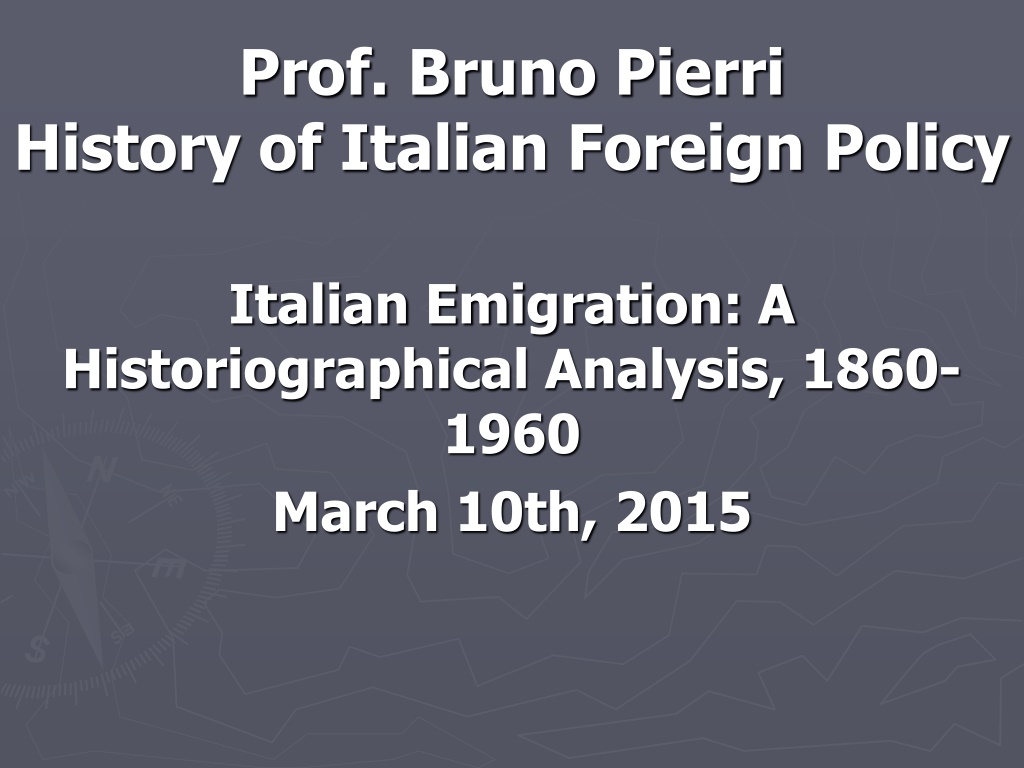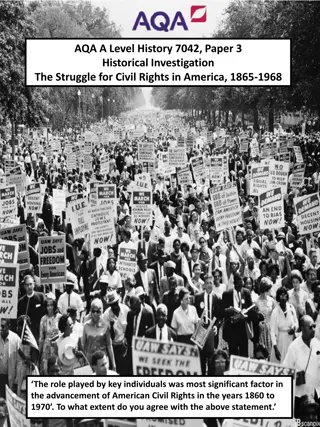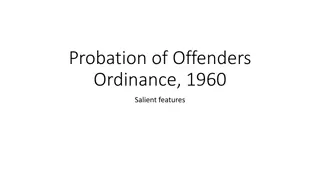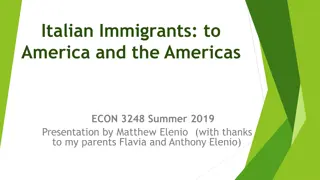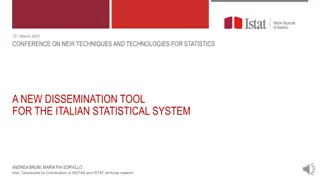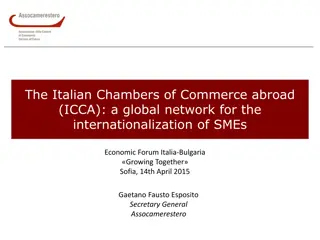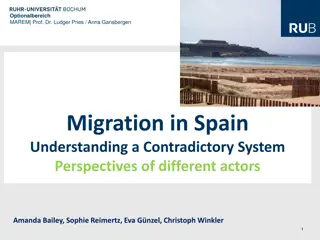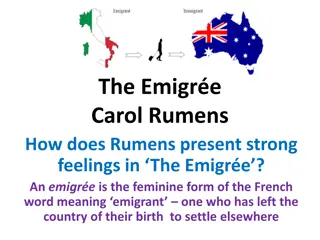Italian Emigration: A Historiographical Analysis, 1860-1960
Italian emigration between 1860 and 1960 saw significant numbers of Italians leaving the country for various destinations, particularly the Americas. The emigration trend reflected the failures of the Liberal state and highlighted issues with the laissez-faire approach, leading to challenges in addressing population needs. Emigration patterns shifted based on economic factors and societal changes, impacting different segments of the population differently.
Download Presentation

Please find below an Image/Link to download the presentation.
The content on the website is provided AS IS for your information and personal use only. It may not be sold, licensed, or shared on other websites without obtaining consent from the author. Download presentation by click this link. If you encounter any issues during the download, it is possible that the publisher has removed the file from their server.
E N D
Presentation Transcript
Prof. Bruno Pierri History of Italian Foreign Policy Italian Emigration: A Historiographical Analysis, 1860- 1960 March 10th, 2015
A few numbers By outbreak of WW2, some 20 million Italians had been involved in emigration process since 1860, of whom 14 million remained permanently domiciled outside Italy Flux restarted after 1945 Further 7million left in following 20 years 1950s:10 million moved within Italy, or Europe, or overseas 1970s: birthrate declined, emigration practlically halted and Italy turned into a country of immigration: some were Italians coming back, others were from other ethnicities
Emigration for Liberal Italy Most obvious failure of State Emigration showed that pretension to feed and defend population was limited For Liberals, emigration was a problem Laissez-faire ideology: Govt not to intrude too far into lives of people Britain had never blocked emigration and this commitment to liberty was secret of success Success did not come in Italy: growing numbers of emigrants 100,000 left in 1876, 293,000 in 1895, 872,000 in 1913 Distant destinations: Americas Before WW1, emigration focus shifted from North to South Sardinia: emigration counted little due to pastoral economy Emigration counted less wherever industrialisation, full-scale agriculture, modernisation and socialism were strong Emigration counted less for great estates labourers and much more for peasants into whose lives market economy was intruding and where land sales were occurring
Issues for Politicians Should many forms of exploitation on emigrants (before, during and after arrival) be curbed or policed by Italian Govt? How could Italy best benefit from emigrants? Money from emigrants to families in Italy helped balancing national budget What did emigration mean for Italian reputation and power? were emigrants lost souls and bodies whose blood to be absorbed to benefit of others, or were they like drops of rain in the sand? Were emigrants conscious of their nationality, or did they need to to be instructed in italianit ?
Legislation Since 1873 Prefects obliged to keep accurate statistics of departures Crispi: only empire could solve emigration problem Giolitti: emigration as safety valve Italophobia in host societies
USA 1904 Italiani arrestati per omicidio
Catholics Some Bishops bewailed fate of poor emigrants exposed to Protestantism or godless materialism Catholic welfare among emigrant communties Collaboration with local consuls and lay intellectuals
Socialists By 1900 socialist chiefs still advised Italian workers abroad to join local unions and forget nationalist particularism Togliatti and Gramsci silent about emigration, but general message was do not emigrate , in order for workers and peasants to stay unite and fight against bosses Left wing has traditionally had limited appeal among Italians abroad
Fascism 1927: word emigrant abolished Regime committed to win battle of births and encouraged rapid increase of population 1928: legal restrictions on permament emigration a) prohibition of stable emigration; b) tolerance only for temporary emigration, as profitable for economy c) qualified emigration of professionals, technicians, and students d) emigration towards Italian colonies e) return of emigrants from abroad
United States Legislation Literacy Act 1917: non admission of illiterates 1921 Quota Act: immigration of only 3% of fellow nationals resident in America in 1910, reduced to 2% of 1890 component in 1924 Italian emigration obliged to deviate towards France, Argentina, Brazil, Australia Mussolini 1922: "Se ci si desse la possibilit di mandare in America un centomila dei nostri sobri ed operosi emigranti, io credo che ne trarrebbe vantaggio tanto gli Stati Uniti quanto l'Italia" - no answer from American Administration Mussolini, May 24, 1924: "Noi non vogliamo mandare negli Stati Uniti la nostra gente ammalata, pazza o pericolosa. Noi pensiamo agli italiani sani quando discutiamo di immigrazione col vostro paese" Mussolini Nov 15, 1924: "Siamo oggi stati colpiti rudemente dall'Immigration Bill. Non basta dire da parte dei popoli che sono arrivati: "stiamo tranquilli", perch se noi non sappiamo dove mandare il nostro dippi di umanit , se non sappiamo dove trovare le materie prime che ci devono far vivere all'interno, questa una pace di aguzzini"
Fuoriusciti They launched political movements Giustizia and Libert They negotiated among themselves to found anti- Fascist popular Front Except from communists, they lacked genuine popular base WW2 gave them chance to end irrelevance and leave their exile F. Parri 1945 Despite this, emigrants abroad had been little affected by anti-Fascist intellectuals Emigration began again soon after war Alcide De Gasperi best solution for poor Italians is to learn a language and go abroad M. Rumor emigration as a process able to safeguard domestic balance against pressure of masses Emigration as necessary tonic for social problems Nationalists and neo-Fascists: change of regime did not alter national interests; unfair to lose colonies
Destinations Massive presence in Argentina 81% of workforce One third of urban population of Buenos Aires Massive contribution to music, literature, arts, science, politics, military In S. America, Italians were appreciated as workers, but were aristocracy of labour 1914: argentinasation of immigrants to be accelerated Italianit remained a nebulous matter, except where subsidy encouraged its disclosure Latin, but not so Italian
Destinations Britain By the 1870s the main regional origins of Italian emigration to Britain were the valleys of Parma in the north, and the Liri valley, half way between Rome and Naples. The people from Parma were predominately organ grinders, while the Neapolitans from the Liri valley (now under Lazio) made ice cream...... After this date all itinerant employment crossed regional demarcations.... But the announcement to side with Germany in 1940 had a devastating effect. By order of parliament all aliens were to be interned. Some had married British women and even taken British citizenship. The Italians were now seen as a national security threat. All Italian men between the ages of 17 and 60 were arrested. They were transported to camps across the country. In the 1950s Italian immigration started again. It was made mainly of southern Italians. But in the 1960s it tapered off and practically stopped in the 1970s. Now London hosts around 400,000 Italians
Destinations USA The early arrivals were scattered throughout the country, with the largest concentration in the northeast. It was there that recognition of their common Italian roots and culture was the greatest. The first Columbus Day celebration was organized by Italian Americans in San Francisco in 1869. Italian American involvement in politics was already underway
Destination USA (1880-1914) The main period of immigration Italian unification in 1861 caused economic conditions to considerably worsen for many in southern Italy. A number of major contributing factors were responsible for the large exodus from southern Italy and Sicily after unification, including: political and social unrest; the government s allocation of much more of its resources to the industrialization of the North than to that of the South; an inequitable tax burden on the South; tariffs on the products of the South; soil exhaustion and erosion; and military conscription lasting seven years. From 1880 to 1920, an estimated 4 million Italian immigrants arrived in the United States. Once in America, the immigrants faced great challenges. Often with no knowledge of the English language and with little formal education, many of the immigrants were compelled to accept low-wage manual-labor jobs About a third of the immigrants, so-called "birds of passage", intended to stay in the United States for only a limited time, followed by a return to Italy with enough in savings to re-establish themselves In time, the Italian immigrants and their descendants adjusted to life in their adopted country, and began making contributions to mainstream American life and culture.
Destination USA: World War I and the Interwar period By 1920, the Little Italies had stabilized and grown considerably more prosperous as workers were able to obtain higher-paying jobs. English was now the language most commonly heard on the streets of the Little Italies The Italian American community wholeheartedly supported the war effort In the post-war years, jobs as policemen, firemen and civil servants became available to Italian Americans; while others found employment as plumbers, electricians, mechanics and carpenters. Women found jobs as civil servants, secretaries, dressmakers, and clerks Italian Americans of the post-war years contributed significantly to American life and culture. In business, Italian Americans were the nation's chief supplier of fresh fruits and vegetables Also in California, Italian Americans were leading growers of grapes, and producers of wine
Destination USA: World War II and the post-war decades At least half a million Italian Americans served in the various branches of the military in World War II In spite of this display of loyalty, hundreds of Italians viewed as a potential threat to the country were interned in detention camps The post-war period was a time of great social change for Italian Americans. Many aspired to a college education. With better job opportunities, and better educated, Italian Americans entered mainstream American life in great numbers. The Italian enclaves were largely abandoned by the younger generation. Many married outside of their ethnic group, most frequently with other ethnic Catholics, but increasingly also with those of diverse religious and ethnic backgrounds Italians continued to immigrate after the war, and an estimated 600,000 arrived in the United States in the post-war decades. Many were well educated
Immigration and Nationality Act of 1952 The Act defined three types of immigrants: immigrants with special skills or relatives of U.S. citizens who were exempt from quotas and who were to be admitted without restrictions average immigrants whose numbers were not supposed to exceed 270,000 per year refugees. The Act allowed the government to deport immigrants or naturalized citizens engaged in subversive activities and also allowed the barring of suspected subversives from entering the country. A) B) C)
Destination Australia Italian Australians are the fourth largest ethnic group By Italian Government estimates, fully two-fifths of its emigrants to Australia were from Veneto and another two-fifths were drawn from Piedmont, Lombardy, and Tuscany Only one-fifth were from Sicily and Calabria
